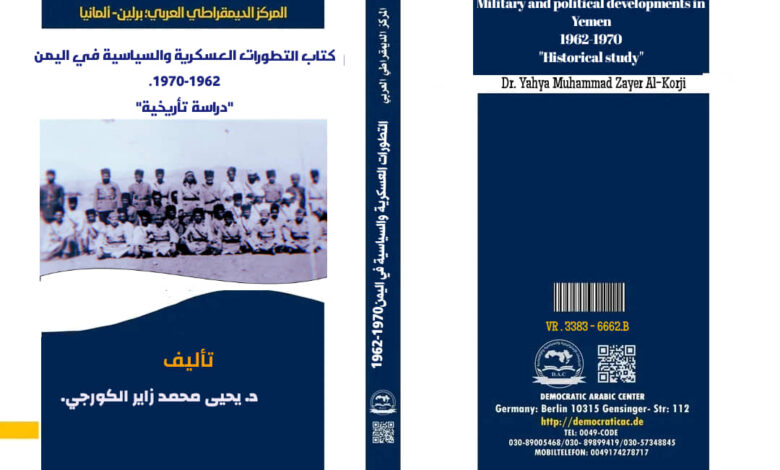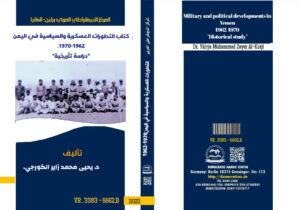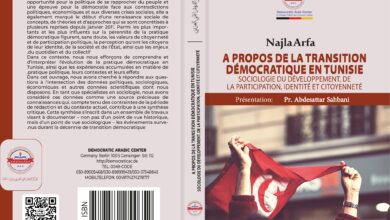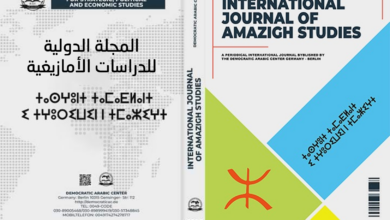التطورات العسكرية والسياسية في اليمن ” 1962-1970 ” دراسة تأريخية
Military and political developments in Yemen " 1962-1970 " Historical study

تأليف : د. يحيى محمد زاير الكورجي – كلية الامام الكاظم عليه السلام للعلوم الاسلامية
نسخة “pdf”-
التطورات العسكرية والسياسية في اليمن ” 1962-1970 ” دراسة تأريخية
الطبعة الأولى “2022″ –من كتاب: – التطورات العسكرية والسياسية في اليمن ” 1962-1970 ” دراسة تأريخية
جميع حقوق الطبع محفوظة #المركز_الديمقراطي_العربي ولا يسمح بإعادة إصدار هذا الكتاب أو اي جزء منه أو تخزينه في نطاق إستعادة المعلومات أو نقله بأي شكل من الأشكال، دون إذن مسبق خطي من الناشر .
تقديم:
تُعد ثورة ايلول / سبتمبر عام 1962 في اليمن أول ثورة في الجزيرة العربية، غيرت النظام السياسي من نظام إمامي ملكي الى نظام جمهوري ، وكان لهذا الحدث صدى واسع على المستويين الإقليمي والدولي ، وتباينت المواقف بين مؤيد ومعارض ، ورغم ان الثورة اليمنية كحدث قد نجحت وسيطرت على معظم المدن اليمنية ، لكن نجاة الإمام محمد البدر، وبعض أمراء الأسرة المالكة، ولجوءهم الى المملكة العربية السعودية ، وطلبهم منها العون والمساعدة في استعادة عرشهم ، حَوَّل الموقف في اليمن الى صراع عسكري وسياسي داخلي ، بدأت أحداثه منذ الأسبوع الاول للثورة بين أتباع النظام الجمهوري المعلن يوم السابع والعشرين من ايلول /سبتمبر عام 1962 ، الساعين الى بسط نفوذهم على أرجاء اليمن، وأمراء أسرة حميد الدين الملكية الساعين الى استعادة عرشهم الذي فقدوه في اليوم نفسه ، وقد استمر الصراع طوال المدة ما بين عامي 1962 و1970 .
ولسوء حظ اليمن أن ثورته وما تبعها من صراع داخلي حدثت في زمن يعيش فيه العالم العربي والدولي حالة حرب باردة ، من علاماتها سياسة الاستقطاب والحرب بالوكالة ، الأمر الذي أثر في الصراع في اليمن بين الجمهوريين والملكيين وحوَّله من صراع محلي داخلي الى صراع اقليمي – دولي ، شاركت فيه قوى إقليمية ودولية بشكل مباشر أو غير مباشر ، مما أججَّه وأطال مدته .
جاء موضوع الدراسة تحت عنوان ( التطورات العسكرية والسياسية في اليمن 1962-1970)، لان التأريخ الأول يُمثل بداية اندلاع ثورة اليمنية في أيلول 1962، في حين يمثل التأريخ الثاني التصالح بين الجمهورين – والملكيين في آيار (مايو) 1970.
إشتملت الدراسة على مقدمة وثلاثة فصول وخاتمة ، وضح الفصل الاول أحداث ثورة ايلول / سبتمبر 1962 تخطيطا وتنفيذا ، ومحاولة الثورة بسط نفوذها على البلاد من العاصمة صنعاء والمدن اليمنية الرئيسة ، ثم توضيح كيفية نجاة الإمام البدر وإفلاته من أيدي الثوار ولجوئه الى السعودية ، وتوضيح الحملات العسكرية الجمهورية لمطاردته ، وفشلها في القبض عليه ، الأمر الذي أدى الى تحول اليمن الى ساحة صراع جمهوري ملكي ، ثم تطور بعد ذلك الى صراع اقليمي – دولي ، ثم يوضح الفصل القوات العسكرية المشاركة في الصراع ، سواء أكانت جمهورية أم ملكية ، من حيث أعداد الجيوش وأنواعها ، والأسلحة والعتاد التي امتلكها الفريقان المتصارعان .
خصص الفصل الثاني للصراع العسكري الجمهوري – الملكي منذ الأسبوع الأول للثورة ، عندما بدأ الملكيون بثورتهم المضادة وهجومهم عبر جبهتين رئيستين ، ومحاور عسكرية متعددة، ضغطت القوات الملكية من خلالها على الجمهوريين قبل أن يلتقطوا أنفاسهم ، متتبعين في هذا الفصل أحداث الصراع العسكري ، راصدين أهم المعارك العسكرية ، التي دارت بين الفريقين حسب تسلسلها الزمني حتى انتهائها عام 1970 ، وقد قسم الصراع العسكري على خمس مراحل، لكل مرحلة ما يميزها من انتصار فريق على آخر ، ولكن ليس النصر الكامل ، وانما كانت المعارك سجالاً ،حتى عام 1967/ 1968، عندما حقق الجمهوريون انتصارا بإفشالهم حصار الملكيين الذي ضربوه على صنعاء ، واستمر اثنين وسبعين يوما ، بعدها توالت انتصارات الجمهوريين ، وتراجع الملكيون وبان انحسارهم ، حتى انتهى بهم الأمر الى المصالحة مع الجمهوريين في عام 1970 ، وخلال العرض التاريخي للصراع العسكري الجمهوري الملكي عملنا على توضيح العوامل والظروف الداخلية والخارجية التي كانت تؤدي الى نصر أو هزيمة أحد الفريقين ، أو تؤدي الى تهدئة الصراع أو تأجيجه .
بينما خصص الفصل الثالث للصراع السياسي الجمهوري -الملكي ، متتبعين أحداثه منذ إعلان النظام الجمهوري وحتى انتهاء النظام الملكي في ايلول / ديسمبر عام 1962 ، وحتى إعلان المصالحة بين الفريقين في آيار / مايو عام 1970 م . وقد قسمت أحداث الصراع السياسي على ثلاث مراحل رئيسة ، موضحا في البداية الخطوات السياسية التي اتخذها الفريقان المتصارعان ، كل منهما يريد تقوية موقفه ، وكسب التأييد والمناصرة الداخلية والخارجية ، مستخدمين وسائل عدة لتحقيق أهدافهما منها : الأعلام ، والدبلوماسية ، والمال ، والسلاح ، وغيرها ، ثم التركيز على الدعوات والمبادرات المحلية والاقليمية والدولية الساعية الى تسوية الصراع وانهائه ، متخذين من اللقاءات والمؤتمرات منابر تصارع من خلالها الفريقان الجمهوري والملكي ، والأسباب التي كانت وراء فشل تلك اللقاءات والمؤتمرات والاتفاقيات ، ثم أنهيت الفصل بذكر بعض الأحداث السياسية ، التي شكلت عوامل أساسية في إنهاء الصراع ، منها اتفاقية الخرطوم بين مصر والسعودية في عام 1967 والتي خرج بموجبها الجيش المصري من اليمن ، وفشل حصار الملكيين لصنعاء في نهاية عام 1967 وبداية عام 1968 ، ثم القناعة السعودية بعدم تحقيق أي نصر عسكري ، ومن ثم سياسي لترويض الجمهوريين ، ثم تخوفها من التغلغل السوفيتي في الجزيرة العربية ، وتقاربه مع الجمهوريين في اليمن ، هذه الأحداث دفعت باطراف الصراع الداخلية والخارجية مجبرة نحو إنهائه ، عندما تصالح الفريقان الجمهوري – والملكي في عام 1970.
ونظرا لكثرة المعلومات المتعلقة بالصراع السياسي ، فقد اتبعت منهجية غير التي اتبعتها في الفصل الخاص بالصراع العسكري ، فاعتمدت على منهج تحليلي أكثر من كونه سردياً ، موضحا المعلومات الرئيسة التي تخدم الموضوع وتوضح الفكرة بشكل مركز ، من غير اللجوء الى التفاصيل التي تؤدي الى تضخيم الاطروحة وأثقالها . وفي الهامش أحيل القارئ على المصادر التي يمكن الرجوع اليها لتفصيل اكثر ، مراعيا في ذلك التسلسل الزمني للأحداث ، ولكن أحيانا كنت اضطر الى الخروج قليلا عن التسلسل الزمني لتوضيح فكرة معينة ، واظهارها بشكل متكامل ، ولكن لا يخل ذلك بتسلسل تاريخ الأحداث العام .
Dr. Yahya Muhammad Zayer Al-Korji
Abstract
The September Revolution of 1962 in Yemen was the first revolution in the Arabian Peninsula that changed the political system from a Imamate monarchy to a republican one and this event had wide regional and international resonance, and positions varied between supporters and opponents. Although the Yemeni revolution succeeded and took control of most cities but the survival of Imam Muhammad al-Badr, and some of the princes of the ruling family and their refuge in the Kingdom of Saudi Arabia in order to seek for their help and assistance in restoring their throne had turned the situation in Yemen into an internal military and political conflict where began on the first day of the revolution among the followers of the republican regime Announced on the 27th of September 1962, looking for extend their influence throughout Yemen and the princes of the royal family of Hamid al-Din seeking to regain their throne they had lost on the same day and the conflict continued throughout the period between 1962 and 1970.
Unfortunately, Yemen’s revolution and its internal conflicts had happened when Arab and international world are living in a state of cold war; marked by polarization and proxy warfare. That affected the conflict in Yemen between republicans and royalists turning it from an internal local conflict into a regional – international conflict. Regional and international powers participated in it directly or indirectly which had inflamed and prolonged . The subject of the study came under the title (Political and Military Developments in Yemen 1962-1970), because the first date represents the beginning of the outbreak of the Yemeni revolution in September 1962, while the second date was representing the reconciliation between the two republics – and the royalists in May 1970.
The study included an introduction three chapters and a conclusion. The first chapter explained the events of the September 1962 revolution, planning and implementation, the revolution’s attempt to extend its influence over the country from the capital, Sana’a and the main Yemeni cities.
The republic’s pursuit of him but it ended with failure to arrest him. That led to big turning point of Yemen into an arena for a republican-royal struggle and then developed into a regional-international conflict. Weapons and equipment owned by the two opposing teams.
The second chapter, was devoted to the republican-monarchist military conflict since the first week of the revolution when the royalists began their counter-revolution attack across two main fronts and multiple military axes which the royal forces pressured the republicans before they caught their breath ; tracing in this chapter the events of the military conflict, observing the most important battles.
The military conflict that took place between the two teams according to its chronological order until its end in 1970. The military conflict was divided into five stages which each stage distinguishes from the victory of one team over another but it was not a full victory .Since the battles were an argument until 1967/1968, when The republicans were victorious by thwarting the siege of the royalists who had struck Sanaa and it lasted for seventy-two days. After that the victories of the republicans followed. The external situation that led to the victory or defeat of one of the two parties either to calm down or inflame the conflict.
While the third chapter was devotion to the republican-royal political struggle, tracing its events from the declaration of the republican system until the end of the monarchy in September 1962, and the declaration of reconciliation between the two parties in May 1970 CE.
The events of the political conflict were divided into three main stages: explaining at the beginning the political steps taken by the two conflicting parties, each wanted to strengthen his position, gain internal and external support, advocacy, using several means to achieve their goals including: media, diplomacy, money, weapons and others. Focusing on local regional and international calls initiatives that seek to settle and to end the conflict by using meetings conferences as platforms through which the Republican and Royal parties struggle and the reasons behind the failure of those meetings conferences and agreements. Including the Khartoum Agreement between Egypt and Saudi Arabia in 1967. According to which the Egyptian army left Yemen.
The failure of the royalists’ siege of Sana’a at the end of 1967, the beginning of 1968, then the Saudi conviction not to achieve any military victory, then politically to tame the republicans and then its fear of Soviet penetration in the Arabian Peninsula and his rapprochement with the Republicans in Yemen.
These events pushed the internal and external parties to the conflict forcing them to end it up when the Republican- and Royalist parties reconciled in 1970.
In view of the large number of information related to the political conflict, I followed a methodology rather than the one that I had followed in the chapter on the military conflict. It relied on an analytical approach rather than a narrative, explaining the main information that serves the topic and clarify the idea in a focused manner. Without resorting to details that lead to amplification and weighting of the thesis.
In the margin, I draw the reader attention to the sources that can be referred to for more detail taking into account the chronology of events. Sometimes I obliged to deviate a little from the chronology to clarify a certain idea, and to show it in an integrated manner without disrupting the sequence of the general history of events.
- الناشر: المركز الديمقراطي العربي للدراسات الإستراتيجية والسياسية والاقتصادية





